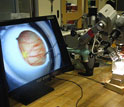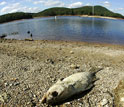News Release 11-130
Multimedia Stories Show How Engineers Shape the Future
A new NSF special report explores frontier engineering research and its impacts on people's lives.

New materials and manufacturing techniques are making energy-efficient LEDs more widespread.
June 28, 2011
This material is available primarily for archival purposes. Telephone numbers or other contact information may be out of date; please see current contact information at media contacts.
The National Science Foundation (NSF) today released a special report featuring the work of a creative group of researchers--engineers who are investigating new phenomena, devising new capabilities, and designing new technologies. Through a series of multimedia stories, "Engineers of the New Millennium" explores how engineers shape the future of robotics, water usage and energy development.
For example, one engineer is creating teams of reconnaissance robots for security and rescue agencies. Another is figuring out how to reuse waste water. And a third is making fuel from algae.
The researchers describe how innovations like these can help the nation overcome major challenges, launch whole industries, and help people enjoy happier and healthier lives.
The multimedia content of "Engineers of the New Millennium," which includes audio slideshows, videos and additional resources, is based on the radio series of the same name. Shows in the radio series were created through a partnership between NSF and IEEE Spectrum Radio that began in 2008 and continues today.
Topics developed for the special report include:
Robots for Real - Robots are emerging from industrial settings to help humans perform surgery, catch criminals, and even fend off the effects of aging. With new capacities for mobility, sensing and intelligence, robots are augmenting human capabilities in completely new ways. Some researchers are pursuing a vision of robots so smart and sophisticated that they can change their shape and abilities depending on the need at hand.
The Global Water Challenge - In a time of growing water demands and aging water infrastructure, engineers are exploring how limited supplies of water can be used--and reused--more efficiently. They are creating new tools for sensing, purifying, and modeling water. They are also reshaping water systems for homes and communities, so that clean water isn't wasted. Ultimately, their work can help communities make more sustainable water choices.
The Energy Revolution - What will America's energy future look like? Light, electricity and automobile fuel still will be needed. But the light could come from super-efficient sources, now possible after decades of research. Electricity will come through a reinvigorated grid, pumped up with intelligence and flexibility. Additionally, engine fuel could be produced by tiny algae, designed to pump out exactly the hydrocarbons vehicles need. Engineers are envisioning this future, and making it happen.
"Thanks to our partnership with IEEE Spectrum, NSF has been able to broadcast engineering research stories on public radio stations across the country," said Assistant Director for Engineering Thomas Peterson. "Now we are delighted to share NSF research outcomes with new audiences via the web."
The special report, "Engineers of the New Millennium," is available on the NSF website.
-NSF-
-
Engineers are developing robotic systems to assist with eye surgery.
Credit and Larger Version -
Engineers create tools to anticipate droughts and lessen their harmful effects.
Credit and Larger Version
Media Contacts
Joshua A. Chamot, NSF, (703) 292-7730, email: jchamot@nsf.gov
Program Contacts
Cecile J. Gonzalez, NSF, (703) 292-8538, email: cjgonzal@nsf.gov
Related Websites
"Engineers of the New Millennium" special report: http://www.nsf.gov/news/special_reports/eng_mill/index.jsp
The U.S. National Science Foundation propels the nation forward by advancing fundamental research in all fields of science and engineering. NSF supports research and people by providing facilities, instruments and funding to support their ingenuity and sustain the U.S. as a global leader in research and innovation. With a fiscal year 2023 budget of $9.5 billion, NSF funds reach all 50 states through grants to nearly 2,000 colleges, universities and institutions. Each year, NSF receives more than 40,000 competitive proposals and makes about 11,000 new awards. Those awards include support for cooperative research with industry, Arctic and Antarctic research and operations, and U.S. participation in international scientific efforts.
Connect with us online
NSF website: nsf.gov
NSF News: nsf.gov/news
For News Media: nsf.gov/news/newsroom
Statistics: nsf.gov/statistics/
Awards database: nsf.gov/awardsearch/
Follow us on social
Twitter: twitter.com/NSF
Facebook: facebook.com/US.NSF
Instagram: instagram.com/nsfgov




